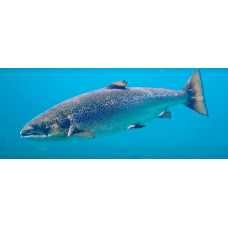Atlantic salmon, noble salmon (Salmo salar) is a passage fish of the genus noble salmon. It lives in the northern part of the Atlantic Ocean. For spawning it enters the rivers of Europe and America. In Russia it is found in the basins of the Barents, White and Baltic Seas. In some lakes it forms freshwater forms. Passerine Atlantic salmon forms winter and spring races. Sexual maturity comes in the 5th-6th year of life. It spawns in rivers at different times (fall, spring, summer). Spawning is in September-November. The female lays up to 10-26 thousand eggs in the nest. After spawning, some fish die. Young fish remain in the river for 4-5 years, feeding on invertebrates and small fish. Atlantic salmon in the sea feeds on crustaceans and fish. Life expectancy is 8-9 years. Very valuable object of fishing.
Scales small, silvery, no spots below the lateral line. Length up to 1.5 m, weight up to 39 kg.
The salmon has a very extensive range. It is distributed in the northern part of the Atlantic Ocean and the western part of the Arctic Ocean. Along the coast of Europe it reaches Portugal in the south and the Kara River in the northeast. In Russia, it enters the rivers of the Murmansk coast and the White Sea, Pechora, and the rivers of the Baltic Sea. Feeding, as a rule, in the sea, where the main source of food is gregarious fish - sprat, herring, herring, three-headed stickleback, smelt and sand lance. Spawning takes place in rivers. Fish of this species that have entered the river from feeding do not feed. Spawning grounds of salmon are located in the upper and middle reaches of the river in rapids, usually on rapids adjacent to the shore. According to the nature of feeding and hydrological regime, spawning grounds are divided into two types: key-fed spawning grounds with high winter water temperature (1-3 °C) and short-term ice cover, and nonkey-fed spawning grounds with winter water temperature around 0 °C and stable ice cover. On spawning grounds of the first type, juveniles emerge from spawning hillocks earlier, but the juveniles grow more slowly than on spawning grounds of the second type. The most powerful natural spawning grounds for Atlantic salmon are located in the Shuya, Umba and Kemi rivers.
It is an object of artificial reproduction. Genetically modified Atlantic salmon (AquAdvantage salmon) was approved by the FDA in November 2015 for sale in the United States.
Atlantic salmon
Tags: atlantic salmon




